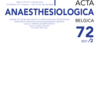Oral and buccal abuse of transdermal opioids : an underdetected but potentially lethal practice
transdermal ; opioid ; buccal ; oral ; abuse
Published online: Mar 28 2022
Abstract
Objectives : Transdermal opioid patches (TOPs) are effective and well tolerated in patients with moderate to severe chronic pain syndromes. Their specific pharmacological properties, however, make them prone to abuse. The objective of this article is to describe the practice of oral and buccal abuse of TOPs and to discuss its clinical implications.
Methods : We present the case of a patient admitted to the intensive care unit after oral abuse of transdermal opioid patches. Additionally, a narrative literature review on the topic is conducted, referring to Pubmed and Embase.
Results : Oral or buccal TOP abuse is the most frequent method of TOP abuse, followed by intravenous injection, inhaling, and applying multiple patches. The main reasons for TOP abuse include drug addiction, suicidal behavior and self-medication. Oral ingestion is potentially lethal because of the high doses of fentanyl that are found in a single patch. Buccal abuse results in fast elevations of fentanyl serum concentrations, caused by transmucosal absorption of fentanyl, thus bypassing hepatic metabolism. During emergency management, naloxone should be administered in a continuous infusion, given the high risk of recurrence of symptoms. Evidence suggests that transdermal buprenorphine is safer in terms of abuse potential. This is explained by its ceiling effect for respiratory depression and its lower peak effects in supratherapeutic doses. Risk factors for abuse include history of substance use disorder, prior opioid overdose and mental illness. Patients with suspected opioid abuse should be referred to pain clinics, mental health specialists or drug addiction facilities.
Conclusion : Oral or buccal abuse is the most reported non-dermal form of TOP abuse. When ingested or chewed, TOPs pose considerable health risks. It is critical to screen patients with chronic opioid therapy regularly for opioid use disorder. When confronted with patients at risk of abuse, close monitoring and referral to specialist care is advised.
